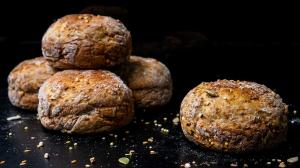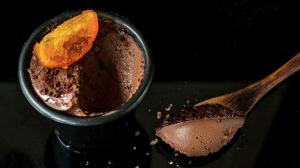It’s only MID-SEPTEMBER so STOP YOUR WHINING because you can still fire up that barbecue (that’s probably still out lying there in the yard or balcony) and pretend it’s still SUMMER … because it is technically ! Here’s an easy, no-fuss, no-mess, delicious and tender IRISH that has become kind of MEDITERRANEAN SODA BREAD great for “emergency” uses, ready in (less than) 90-MINUTES, from start to finish and this includes preheating the oven and letting the bread cool down after baking it !
This bread was a discovery for me, not because I was looking for another bread recipe but because I needed an easier, softer and extremely rapid bread for several last-minute uses (like soft hamburger buns with a nice crust on the outside or maybe even bread bowls to hollow out and fill up with an “end of (and desperately still trying to hang on to) summer salad”.
I’ve been doing a lot of experimenting with yeast, sourdough starter and flour mixes lately and I thought I was going to publish the post on how to make a sourdough starter first, followed by an easy 1-2-3 foolproof sourdough bread the following time, then perhaps a soda bread and finally a sliced sandwich bread recipe in the end (see the recipe here). But I’ve done it all backwards. That’s life.
Here’s a quick & easy Irish soda bread with modified ingredients to make it more "mediterranean" that requires no yeast. What's soda ? It's just BAKING SODA and it also substitutes the traditional BUTTERMILK with kefir. What’s KEFIR ? It’s a North African, Near Eastern, Balkan and sometimes Eastern European version of buttermilk.
And why ? Because we’ve all started up with work and/or school and something quick & easy is what we need now before adjusting to our new schedules !
THIS is a SIMPLE BREAD to make : no yeast, no kneading, no waiting. In fact you have to work quickly. Instead of yeast, you use baking soda. This baking soda will react very quickly with the fermented milk or kefir or buttermilk to make it rise. I also play around with the liquids, sometimes adding an egg and some oil and reducing the amount of kefir by the exact weight of that egg and oil for an even more tender result, especially if making smaller hamburger or bread buns as opposed to a larger loaf of bread that will be sliced. You can play around with that.
When making a large loaf, you’ll need to place the dough on a large piece of baking paper to transfer it to the very hot pre-heated baking dish because it’s too soft to handle but when making smaller buns or rolls, you can omit the use of baking paper and shape the smaller dough balls in smaller bowls sprinkled with flour which makes them rounder, firmer and less sticky thus easier to handle.
After your first trial, you can adjust it to your taste. You may decide to slightly increase the ratios and proportions. To make it easy, I use equal weights of dry ingredients to wet ingredients (excluding the salt, baking soda & sugar). If you use other types of flours, you can slightly increase or decrease the liquid content by 10-15% more or less because strong flours like wholewheat or bread flour will absorb more water than regular white all-purpose flour.
Every RECIPE needs ADJUSTMENTS. I had some overseas friends over for dinner and we were talking about how different our breads are, even though we’re using the exact same recipe. They live in Montreal, I live in Paris. Our ingredients are not exactly the same, the yeast we’re using may be fresher and more active or older and less effective, our water is different, the temperature and humidity levels are definitely different, our ovens are different too. Our breads using the exact same recipes yield slightly different results so just ADJUST the recipes ! After your first trial of any recipe, you need to take notes and adjust it for the second time you try it and so on and so on. Every recipe should be modified to your taste but also to your ingredients, equipment and environment.
JUST GIVE IT A TRY and next week, maybe we’ll talk about making “back to school & work” foods and how we already miss the warmer summer days . . . :)













